Last Thursday, we were graced with what promised to be the biggest Magic: The Gathering and Dungeons & Dragons announcement of the year.
Without further ado, today we're going to review the show's presentation and products announced for Magic in 2023.
About Wizards Presents
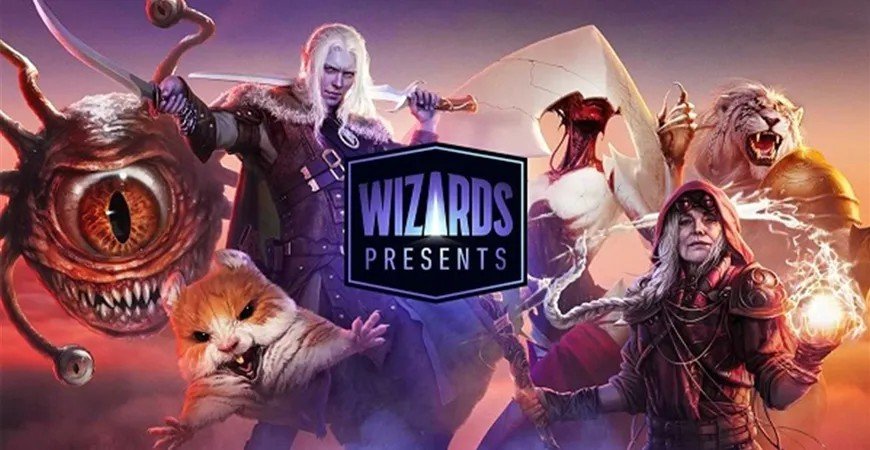
The reminder that Magic is just a product to be sold.
Let's start with the event that highlighted all the new products for the next year: Wizards Presents — For that, I'll only be taking into account what was shown about Magic: The Gathering, since I don't have enough Dungeons & Dragons expertise to coherently comment on this topic, in addition to considering only what was revealed before we got into Dominaria United's debut, as they are technically two different programs that the company patched together. And as far as the MTG universe is concerned, the entire presentation was... generic, unimpressive and downright commercial.
While, on social media, there were people screaming in droves and aboard the hype train to the extreme, all I could watch and evaluate was the atmosphere of the show: little to no immersion in the game's universe, standard TV show music, hosts that were clearly reading teleprompters. Everything was too robotic and unwelcoming —a mere commercial advertising, as if to say "Hey, here are the products we hope you'll buy next year!" and nothing more, it felt like watching a TV show on a Sunday afternoon.
This leads us, consequently, to a point that I reinforce since one of my first articles at the end of 2020: Wizards of the Coast is a subsidiary company of Hasbro, and Magic: The Gathering is a product to be sold — Everything else is a community creation: the passion, the hype, the singles market, the content creation... it's all in the hands of the fanbase, and they don't have to spend resources feeding these points anymore as the machine already works very well on its own.
I particularly believe that this posture is bad for the game, that the notorious increasingly commercial positioning that Magic has adopted makes the brand look like just a money-making machine, devoid of essence, purpose, or any other intangible value that isn't manufactured by the imagination of a passionate community and a long chain of content creators and businesses that need to be constantly updated to keep their incomes and jobs running smoothly.
And if Wizards/Hasbro feels that it no longer has to put in the effort to captivate its audience and only needs to demonstrate the new products for people to automatically build the collective hype and buy — basically what has been happening — then this is a sorrowful time for Magic, its legacy and everyone involved in the incredible history of its 30 years, since from the moment the game is explicitly treated as just a product, the magic within it ceases to exist.
At this point, you might be thinking "but everything in the entertainment area is a product to be sold, so what's the problem with a presentation intended to show the next releases, trailers exist for the same reason?".
And honestly? It is true! Trailers are nothing more than an advertisement for a product to be consumed later. It's all marketing, but the crucial difference is in how you present your product — and how Wizards presented next year's release window was abysmal because it didn't feel special at all, even though it was advertised as if it would be the biggest Magic and D&D event of the year — Wizards Presents was a show that struggled to fit all the products in an hour, turning it into an advertisement devoid of any essence.
The show hasn't captured what Magic stands for or the intangibles that go hand in hand with the product, or the depth of its lore, or the importance the game has to the players... The program failed to convey any message that wasn't "purchase our next products and attend to our events."
Well, except for a moment—and we need to talk about him, too.
Post Malone on Magic is cool, emphasizing an inaccessible product isn't.
I like Post Malone. I mean, some of his songs are cool, he seems like a cool guy, and having him as a genuine Magic: The Gathering poster boy is a good realization on both a commercial and social level, as he decouples the game's recurring image to a bunch of weird nerds, or whatever. In other words, Post Malone makes Magic look cool, and I like that, so I don't see any problem with Wizards investing in this association between him and the MTG brand, creating an exclusive card for the rapper, etc. — it's a beneficial trade for a celebrity who is apparently passionate about the game.
That said, I just loved this commercial because it captures the essence of what Magic should be: a game about The Gathering — everyone is enjoying themselves while having drinks, snacks, playing a Commander table, laughing, having a good time together. In a world where most content is geared towards competitive topics and the tournament scene is constant, it's easy to forget to enjoy the simple things like the personality of the person playing with you across the table.
Competitive Magic brings with it a rather hostile environment, and we are constant victims of pressuring ourselves too much for our results and taking unfriendly attitudes towards people. To have this video saying that the game goes beyond tournaments, that it's also about having fun with the people around you, sitting with them, having a few drinks and just enjoying the game because you enjoy each other's company is a powerful message, and many people can learn a bit more from it.
This commercial is just perfect, until Post tapped some Old Duals to cast Chromatic Orrery. The problem with that? Being a piece of advertising which showcases a product inaccessible to more than 90% of Magic players emphasizes a notorious discrepancy in the acquisition of new cards.
When you show pieces of cardboard that are worth hundreds of dollars in a piece of advertising, you might be representing the historical content that Magic: The Gathering has, but when the person who watches the commercial due to Post Malone becomes interested in his deck, they will find out the price of an Old Dual, and might quickly drive them away from the game believing it to be a costly and elitist hobby, and there will be no one to explain that there are Commander precons and other more affordable products.
It's not that this spoils the commercial, it's a work of art that uses a world-renowned celebrity to show that Magic is a game where you can enjoy the company of your friends and have a good time, there was only one crucial flaw in emphasizing expensive products with a scarce and limited supply.
And now that we're done with my outrage over Wizards Presents, we can talk about what, in fact, was announced.
A 2022 retrospective
Last year I wrote a article where I speculated about 2022's releases, and I think it's opportune to make a brief recap of my take on each set.
In Kamigawa: Neon Dynasty, I mentioned it would have the return of Ninjutsu and tribal support for Samurai, in addition to prioritizing utility lands over Dual Lands, that Tezzeret would be there, and Ninja of the Deep Hours would be reprinted as uncommon.
In Streets of New Capenna, I mentioned the possibility of demons outside the traditional colors, of a new cycle of tri-lands that I didn't believe would be Triomes, and of having a keyword geared towards graveyards.
In Dominaria United, I speculated on the return of Domain and other abilities inherent to the plane, and that it would have a focus on tribal cards and a good opportunity to reprint the Painlands.
The Brothers' War — A Journey into dark times
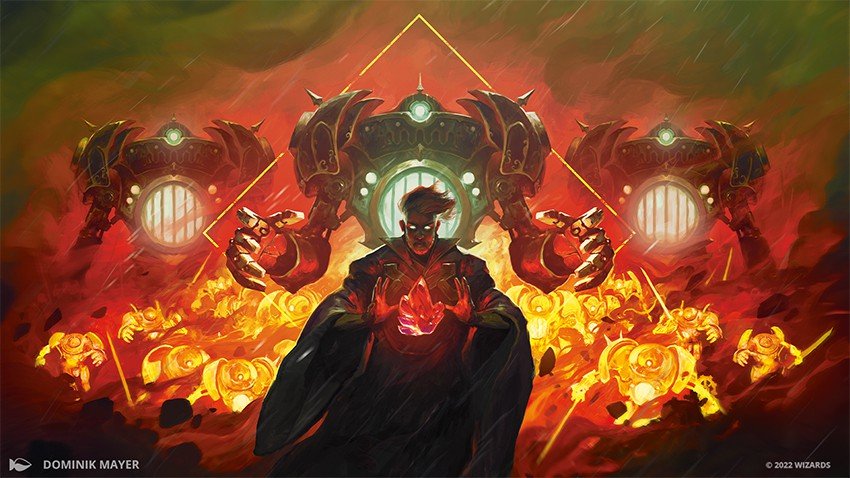
As for The Brothers' War, speculations that have proven factual so far are that this set will be split between the factions of Urza and Mishra, and that it is part of the New Phyrexia arc.
Other of my speculations were that Urza could come as a Planeswalker (which would be unlikely, but not impossible) and that the set would focus on the catastrophe of the War rather than the central characters — but now we have a point to consider: The Brothers' War will be about Teferi's time travel to discover how the Sylex works — and that could have serious applications for the game's Lore, but we'll discuss it later. Here, we'll focus on the set.
A highlight on the war's victims
Let's face it: The Brothers' War was a no-winner battle with countless losers.
Although Urza emerged "victorious" and became a Planeswalker, Dominaria was taken to the Ice Age and the explosion created the Shard of the Twelve Worlds — it was an unprecedented catastrophe and during the original story, we've seen much of the actions of the two brothers and little of their practical impact on Dominaria.
With Teferi being our "narrator" in the next story and probably avoiding actively meddling in the clash to avoid causing an interference that could alter the present, I believe we will have a broader view of the impact that the war had on Dominaria, also reminding us that Urza never was a very heroic figure.
Two distinct artifact-focused mechanics
The Brothers' War was a battle between two extremely talented artificers who used the deadliest machines their minds allowed them to create to fight battles across Dominaria. And I still believe we will have mechanics that will exemplify this warlike power on both sides — but where I previously believed Metalcraft would be that ability, today I believe we will have two distinct elements to exemplify this as Urza and Mishra will represent factions.
Of course, one of those mechanics could still be Metalcraft or any other that cares about artifacts, like Improvise (I won't mention Affinity as Improvise is the fixed Affinity) — but it sounds more coherent to me if each of the brothers has a distinct and new ability that fits thematically with their individual philosophy towards their creations.
Younger Urza and Mishra cards

The first illustration we had of this set, back in 2021, showed an older Urza and a Mishra battling each other — this Urza already has a card, by the way.

Given how much I believe Wizards considers this Urza too strong for Standard, and since The Brothers' War product illustrations now feature more youthful variants of both parties, I believe we'll have new Urza and Mishra cards, prior to the ignition of Urza's spark (which happens after he activates the Golgothian Sylex).
That said, the 0/0 Construct that gains +1/+1 for each artifact you control has already become Urza's trademark:

So, it makes sense to me that his card in this set has some interaction with these tokens or even creates it through an ETB or activated ability.

Mishra has much less hint of mechanics, as most of his cards or permanents named after him doesn't interact with each other. But if they use the previous version as a basis, it would make sense that he has some relationship with the ability to copy artifacts or even be a sort of powered-up Birthing Pod for artifacts.
Phyrexia: All Will Be One — At last, the return of the game's greatest antagonist
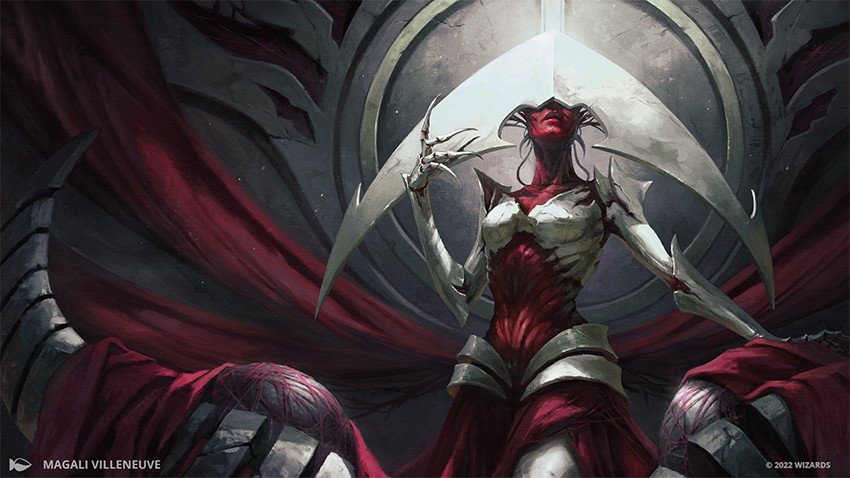
Taking place in parallel or with Teferi's return from the past, we'll be heading to New Phyrexia. The set will probably progress the plot, but I think many of its cards will focus on showing what Mirrodin has become after the Phyrexian invasion, how the plane has changed, and what they plan on with The World Tree.
I'm hoping that the clash between Phyrexia and the Planeswalkers will start later in this set instead of trying to make a big climax on the next release, as they did with War of the Spark — this makes room for plenty of iconic moments instead of trying to cram everything into one release and neglecting a few key points and important characters.
Phyrexian mana, but with adjustments
Phyrexia has two mechanics of its own so far: Phyrexian mana that allows you to pay mana costs with life, and poison counters.
We all know how much Phyrexian Mana is broken — cards like Gitaxian Probe and Mental Misstep are banned from pretty much every competitive format, and other spells like Gut Shot, Dismember and Mutagenic Growth are or were heavily present in Modern, Pauper or Legacy — so I don't think they'll bring it back and apply it in the same way as in New Phyrexia.

Instead, I believe we will have a version adjusted to normal game standards like Compleated for Planeswalker, where you can pay Phyrexian mana, but have the drawback that it enters the battlefield with fewer loyalty counters.
In the case of creatures, this is pretty easy to apply: just assign -1/-1 counters to each time you pay the Phyrexian mana cost, and that will normally balance any creature you can cast if its ETB effects or static abilities aren't insanely powerful.

But the problem with Phyrexian Mana were never creatures, but playing spells and activating abilities for free.
In the case of abilities, it's a simple matter of avoiding overly powerful effects with Phyrexian mana costs, but spells are a puzzle: either they'll have to add an enclosure to spells that allows you to pay a certain alternative cost that includes Phyrexian mana, but that reduces the spell's power — like a reverse Cleave — or they'll have to ensure that Phyrexian costs never cause a color pie to break or allow them to cast spells for free, or at a very low cost.

An example of this ability would be a Dismember for 

Poison Counters
It's kind of obvious that we will have a return of the poison counters mechanic - Ajani, Sleeper Agent already announces this, the question is whether this will be the return of Infect, or if we will have a new method of poisoning players.

Infect is an interesting mechanic, and worked well with the Phyrexian theme during the Scars of Mirrodin block as they were spreading and literally infecting the Mirrans, but it doesn't seem to fit that well when it comes to an already conquered plane. Also, Infect is a somewhat parasitic ability that only works with itself, and all external interaction with it is basically geared towards attempts to break it through pumps.
Therefore, I believe that Wizards may prefer more interactive and alternative ways to make Poison a viable or fun wincondition without making the player need to create a deck specifically aimed at Infect, making it closer to an auxiliary wincon rather than your main game plan, if you prefer.
There are several ways to do this: spells and permanents with ETB and LTB that add poison counters, or some new ability that allows the creature to switch between regular damage and Infect damage, or permanents that add poison counters when you take an action, Proliferate, among others.

I can also imagine situations where they decide to use Poison as a pseudo-punishing mechanic for players — you can even do this coupled with the Phyrexian mana cost — by turning poison into a concept of using Phyrexian powers at the risk of being corrupted by them.
Fast Lands Reprint

If we're heading back to New Phyrexia, we're theoretically heading back to the plane that was once Mirrodin — this is the perfect time for a reprint of the allied Fast Lands that Pioneer seriously lacks for some of its best strategies, and just like Dominaria does reference to the Pain Lands locations, the allied Fast Lands are specifically Mirrodin/Phyrexia locations today.
Maybe this reprint will come in March of the Machine: Aftermath instead, but either way, it's a perfect opportunity, and too good to pass up right now.
March of the Machine — The Set that will change Magic forever
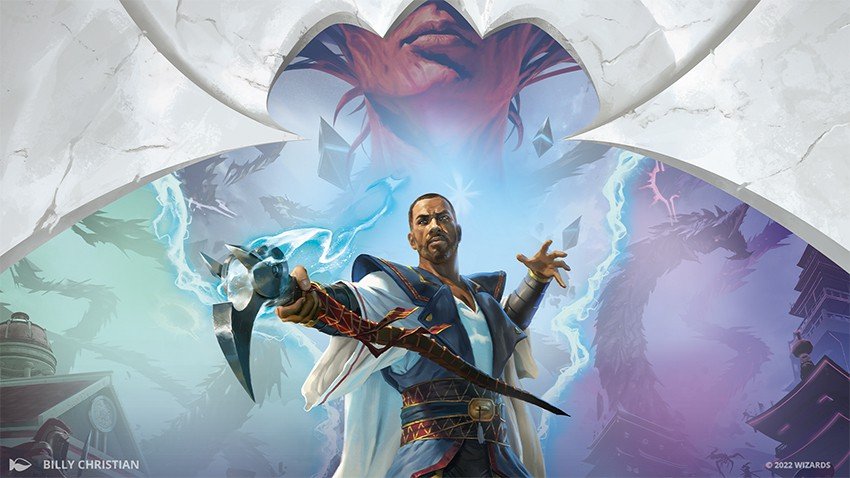
An epilogue similar to Avengers: Endgame?
March of the Machine will be the epilogue to the New Phyrexia saga, and pretty much every poster we've seen so far demonstrates massive interplanar combat — we know Chandra, Baral (from Kaladesh), Esika (from Kaldheim), Borborygmos (from Ravnica), Dina (from Strixhaven) and a dragon from Kamigawa will be involved in the story, and we also see Zendikar and Theros in the promotional image above.
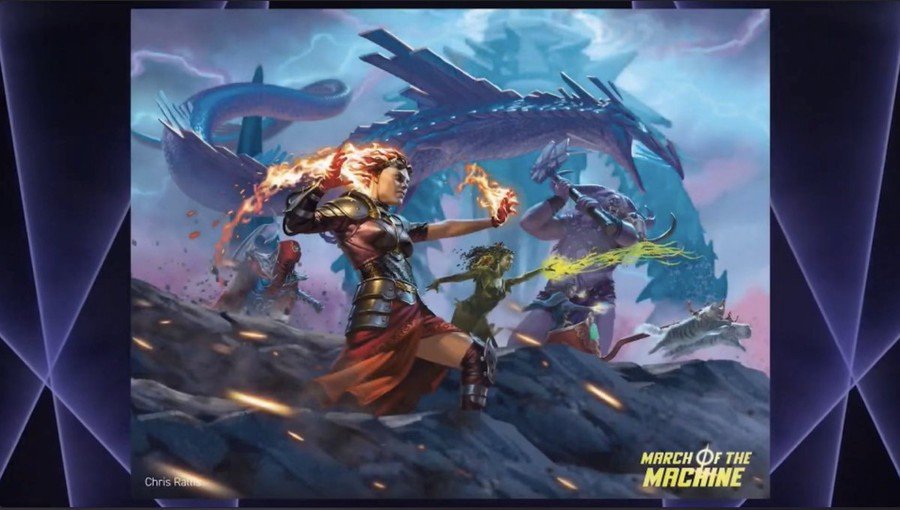
Honestly, this is too "Marvel" — more specifically, Avengers: Endgame — for my taste, simply because I know Magic: The Gathering can be a lot more than that. But my opinion aside: the promise is that March of the Machine will be so impactful that it will change Magic forever, and I have some theories on how that could happen that I intend to elaborate in an upcoming article.
Changes to the Blind Eternities
For those who don't know, the Blind Eternities are what exists between the planes of the Multiverse. It doesn't have a specific shape, and basically nothing that isn't a Planeswalker can stay alive or whole there with ease - perhaps it has something to do with the physical and material form of existences, as the Eldrazi are native to this place and lack a physical manifestation until they enter a plane.
The thing is, "normal" beings shouldn't planeswalk as they'd be decimated in the Blind Eternities — the Phyrexians use Planar Bridges for that, and Urabrask himself was seriously injured using them to get to Capenna — so there will likely be a moment in history where the heroes will use Planar Portals to bring beings from other planes to New Phyrexia, or that Phyrexians will use Planar Portals to invade or unify multiple planes into one, and that is sure to cause an unreasonable tension to the Blind Eternities, which might bring severe consequences.
There are plenty of things I would like to see happen during this arc, and countless theories on how it will change Magic forever, but I think it's too long a topic that deserves an article of its own rather than giving a short version here — but I'm pretty certain that, whatever big impact this set will have on lore, it will definitely go through the Blind Eternities.
The Aftermath — A non-Standard legal set?

The aftermath of the events which takes place on March of the Machine will be demonstrated in a special set called The Aftermath, which aims to tie together the loose ends of this story and provide an epilogue to the New Phyrexia arc.
The initial idea was that this set would be another release in the Standard window, but Mark Rosewater commented on Twitter that The Aftermath is a new idea that isn't just an ordinary premier set — which makes me wonder if it will be Standard-legal, given the notorious absence of a Master set in what was announced for next year.
Typically, a year in Magic: The Gathering contains three to four special booster products - Dominaria Remastered is one of them and Tales of the Middle Earth would be the equivalent of Modern Horizons 3, so there remains one product that has yet to be announced, and in that case, it might make sense that this third product would be March of the Machine: The Aftermath.
Of course, releasing a special product with the same name as a Standard set would bring a lot of confusion when it comes to understanding what is legal in the format, but it's not the first time that Wizards has done something confusing that messes with the perception of what can or cannot be used on Standard.
Wilds of Eldraine & The Lost Caves of Ixalan
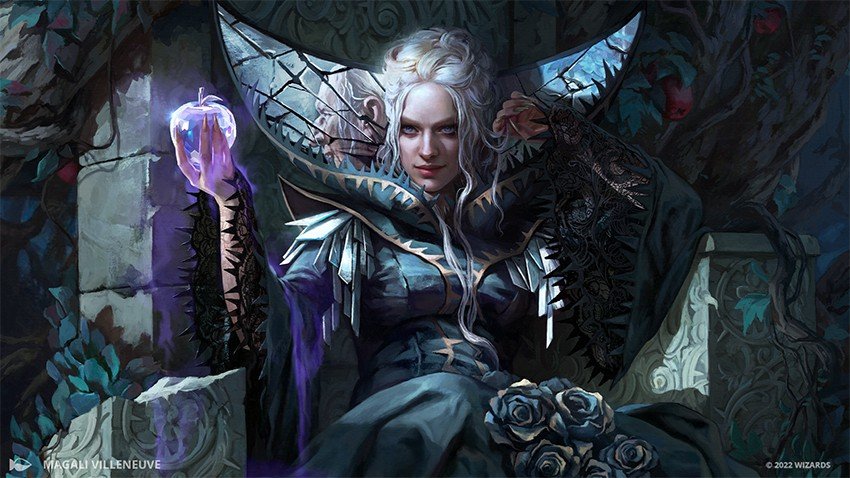
More fillers?
Here's where things got uninteresting for me: as much as I liked Eldraine (and not so much about Ixalan), it feels like we'll be back in the "filler sets" cycle after March of the Machine — Of course that we can't always have an epic showdown, but the stories of the last few sets without a story arc were just... bad, and that's one of the things I miss about the block structure: the stories had a beginning, middle, and end that you followed throughout the year, rather than trying to cram it all into a single short story and leave it messy and chaotic to follow along.
However, I could be wrong: March of the Machine promises to change Magic, and who knows, the next adventures in other planes will serve to demonstrate the impact and consequences of this epilogue, as they already promised to do in The Aftermath? Who knows, maybe new characters and interesting stories will appear? Or maybe they are the indirect events that will lead us to the next big plot in the game.
There are many possibilities here, and only time will tell what will happen in Eldraine and Ixalan, and whether the events depicted in these sets will be relevant or just one more in the long series of "the Planeswalkers' amazing adventures".
Universes Beyond — Doctor Who & Tales of the Middle Earth
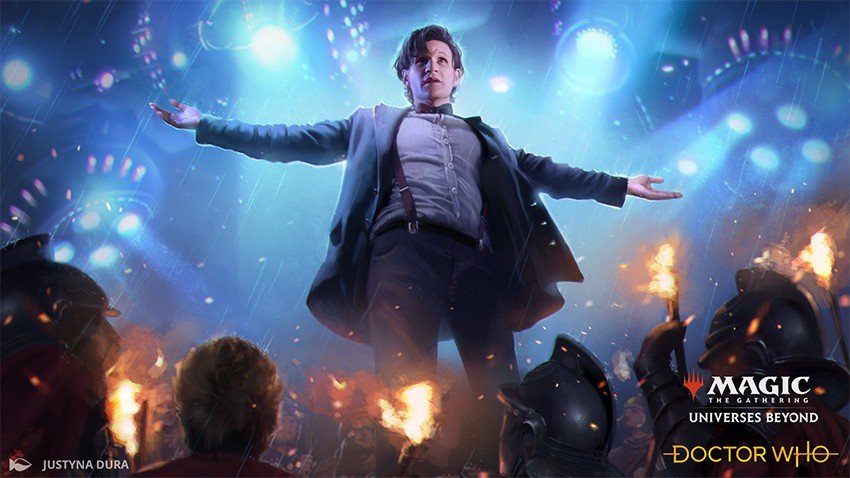
Like it or not, Universes Beyond is a thing, and it works
Every time a product in the Universes Beyond series is announced, a more nostalgic portion of the community roars in endless complaints about how the game is supposedly dying, even though Wizards is breaking sales records every year.
Everyone has the right to like and dislike things related to their hobby or a product, I have demonstrated a number of things I don't like in this article, but we need to accept reality as it presents itself, not as we would like it to be — only then will we can define, with the necessary discernment, what is best for us as human beings and consumers — and if you don't feel that this product brings you something, just don't buy it.
Like Post Malone, the Universes Beyond series helps Magic look cool to the outside world. None of their products have captivated me yet, as they haven't even come close to the series and games that I'm a genuine fan, but they add to the fans of those franchises and make people hear about Magic, attracting potential customers and helping to make the game more popular.
Yes, it's a profit-driven decision and I have a lot of criticism about how commercial Magic: The Gathering has become, but that shouldn't be reason for me to simply rate these products as bad — each case has a specific difference, and we're still evaluating how much this series can affect the game, which brings us to the second point.
Impacting competitive formats with hard-to-reprint products
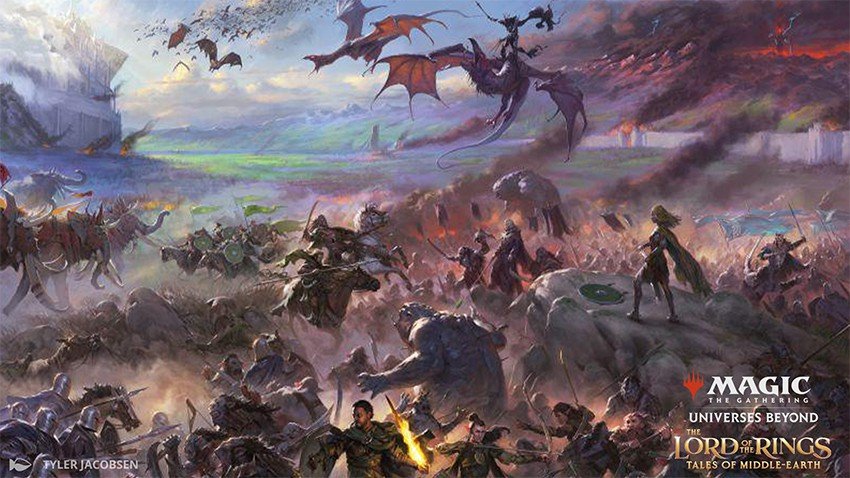
Starting in October and throughout the next year, there will be three Universes Beyond products that will be available to the general public rather than limited to the Secret Lair series: Warhammer 40K, Tales of the Middle Earth and Doctor Who.
Warhammer and Doctor Who will be Commander products, meaning a more impactful presence of universes outside Magic on casual or competitive tables of the format, and some exclusive cards may even show up in Legacy - but the big challenge for Wizards in relation to the products from the series will come with Tales of the Middle Earth, a Modern-legal set.
Potentially being Modern Horizons 3, the special Lord of the Rings set might significantly alter Modern's competitive Metagame and create archetypes on its own in the same way that Modern Horizons products did — which will lead to peculiar situations where you might be attacking with Ragavan, Nimble Pilferer and Frodo in the same deck, or your opponent can cast an Aragorn, or have its spell countered with a "You Shall Not Pass", among other possibilities.
The problem is if these cards are as impactful as a Modern Horizons product, as they're notoriously harder to reprint without going through the same process they did with Stranger Things' Secret Lair, where Eleven, the Mage and Cecily, Haunted Mage are the same card — which would work well and could be easily implemented, but would bring more headaches and another layer of complexity that the game hardly needed.
Does this mean that Tales of the Middle Earth should have a low-power level to avoid impacting Modern as much? No, I'm just really intrigued by what the long-term impact of the decision to make this universe an integral part of competitive Magic will be.
Conclusion
That's all for today. If you have any suggestions or opinions, feel free to leave them in the comments.
Thanks for reading!

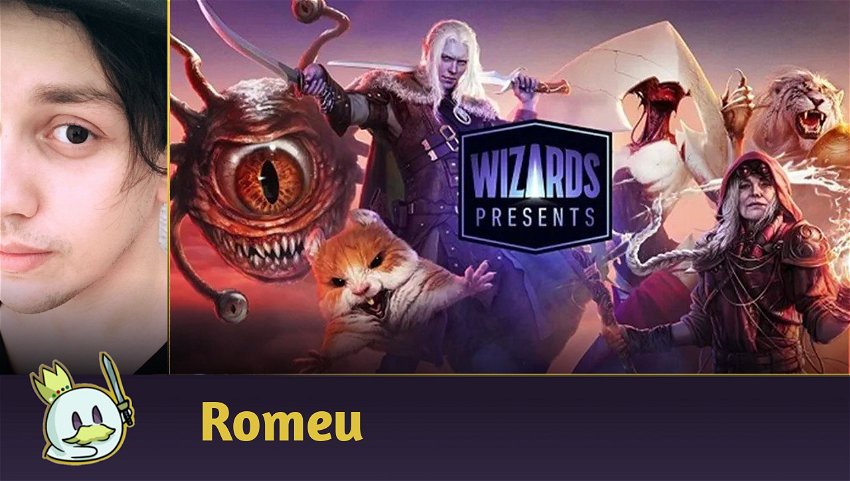







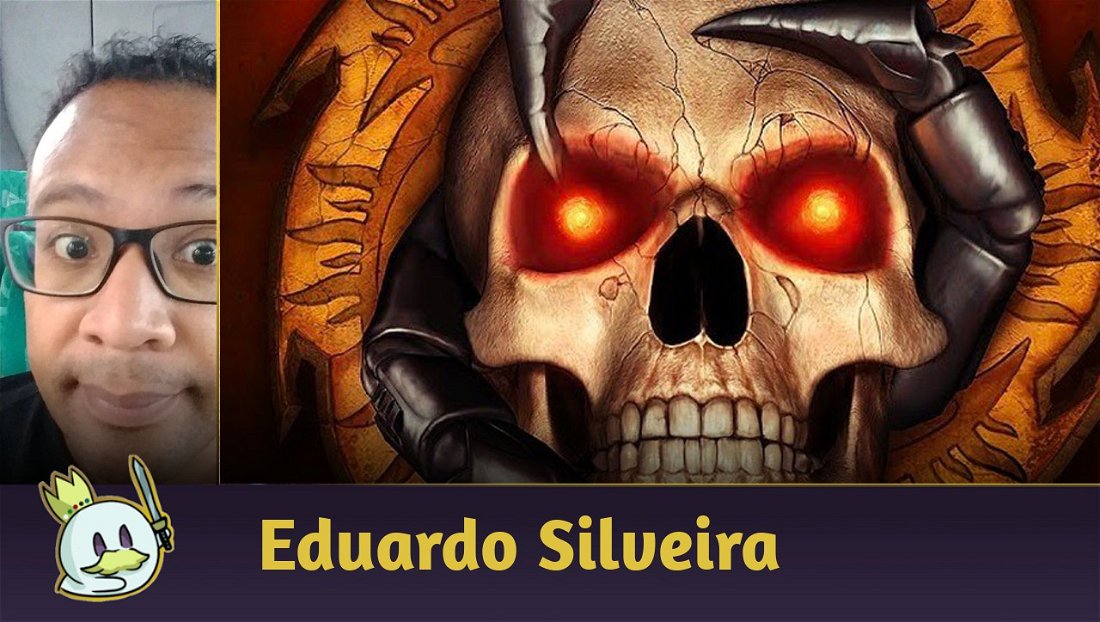
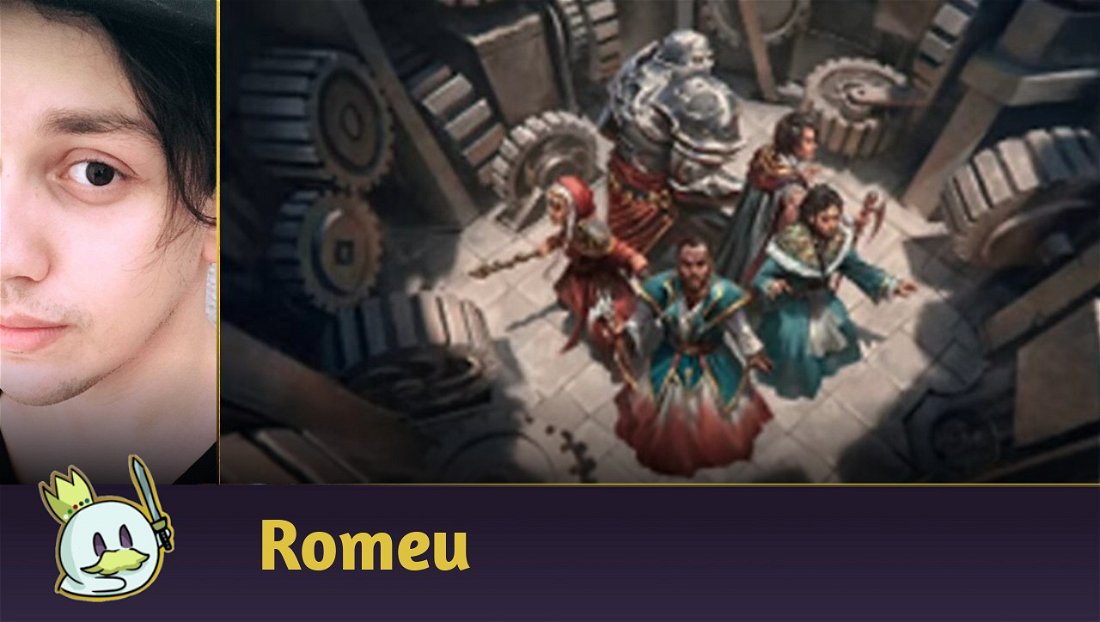



— تعليقات 0
, ردود الفعل 1
كن أول من يعلق